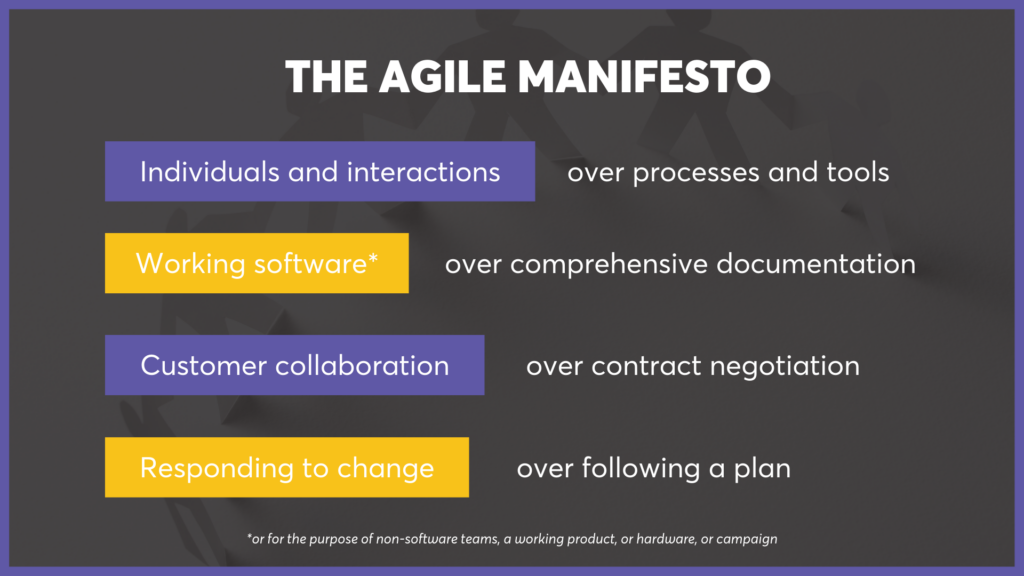Moving beyond the IT and software development space, more businesses are looking at the Agile methodology to organize work and teams for improved collaboration, alignment, and productivity. This article will provide an in-depth and beginner-friendly guide about Agile, including its history, its benefits, and all you need to know to move your teams toward a new way of working.
Table of Contents
- What Is Agile and Why Does It Matter
- The Evolution of Agile: Past, Present, and Future
- Why and How Agile Can Help Non-Software Teams
- 5 Best Practices When Getting Started with Agile Transformation
- The Biggest Misconceptions about Agile
- Recommended Resources to Dive Deeper into Agile
What Is Agile (And Why Does it Matter)?
Agile is an umbrella approach to organizing work that has been around for more than two decades. In theory and practice, teams adopt agile methods and frameworks to respond effectively to change and promote greater flexibility in their work. Furthermore, adopting an agile mindset can positively impact how organizations work by promoting better team alignment across functions and goals, improved collaboration between individuals and teams, and increased opportunities to learn about customer needs.
It’s no secret that the introduction of the internet in the ‘90s (and the rapid digital transformation that followed in the new millennium) forced many businesses to adapt or decline. This reality meant companies need to be more flexible and adopt new working methods that push them to remain relevant and competitive.
Whereas other popular project management methodologies such as Waterfall promote rigorous planning, the Agile manifesto promotes short-term loops that include planning, testing, learning and iterating on solutions. In other words, agile introduced a lot of flexibility to teams who need to respond to customer needs in real-time.
Agile can help businesses and teams organize their work to deliver value to customers more effectively and on time while also learning how to improve their products and services.
The Evolution of Agile: Past, Present, and Future
While organizations are increasingly turning towards a more agile way of working, it’s worth exploring the roots of agile to understand how it can transform your business.
In the early 1990s, the software development industry faced what is now known as the application development crisis. Nowadays, it is unimaginable to wait for software updates for more than a year. In fact, we’re constantly alerted to accept software updates and restart our devices. This wasn’t always the case.
Before the increased use of computers and the internet, software teams didn’t have to bother building and updating software applications for an average of three years and sometimes even more. At the time, software development teams organized their work using the Waterfall methodology – a popular engineering process to develop, build and launch projects. The methodology helped teams organize complex developments through heavy planning and rigorous discipline. While it worked for a while, software teams began to feel restricted by the methodology’s prescriptive process.
Once large enterprise companies shifted their day-to-day operations to computers and the internet, software development teams were bombarded with customer demand to create better software faster than they could.
With business needs outpacing the ability of software development teams to deliver necessary application updates, industry leaders started to wonder if there was a better way.
As frustrations and backlogs continued to grow, like-minded software leaders frequently met to discuss and share better ways of developing and updating software to keep up with the increasing demand. The goal was to find a lighter-weight methodology that would allow for more flexibility and less planning and definition. More accurately, they wanted to define a new process that gets applications into the hands of users faster and creates a feedback loop to inform future development.
During this time, leaders from across the software industry shared different frameworks and methods that they’ve tested within their teams to meet the demand of the customers. As a result, the different methodologies started to spread and grow organically through these informal and grassroots discussions.
Then in 2001, 17 industry experts, practitioners and leaders met to formulate an umbrella term to emphasize the common themes and concepts to help software teams create lightweight solutions, promote learning, and allow flexibility and collaboration.
While they didn’t agree on everything, the 17 leaders authored what is now known as the Agile manifesto and the 12 principles to guide decision-making and actions.

Shortly after authoring the manifesto, some of them decided to form a non-profit organization called Agile Alliance. The main goal of its creation was to spread information about agile and how software teams can adopt an agile mindset.
The Agile Manifesto remains the go-to document for software teams two decades after its launch. Agile is being recognized and adopted in non-software functions across companies and industries. Leaders are looking to agile to help them transform how they work and deliver value to their customers.
Why and How Agile Can Help Non-Software Teams
Earlier, we touched on why agile matters, but how should non-software teams take advantage of this philosophy in an ever-changing world?
While agile was popularized in and by software teams, it can easily lend itself to other aspects of the business. Today, more non-IT teams and leaders are looking at adopting agile to counteract the top-heavy, bureaucratic processes that proved too rigid and inflexible in the face of massive global disruptions.
According to the 15th State of Agile Report, 94% of survey respondents confirm that their company practices agile, and 52% say that at least half of their companies have adopted agile. Besides IT and software teams, operations, marketing, and sales have adopted agile practices and principles.
In terms of the benefits of adopting agile, multiple industry research outlined three consistent outcomes that improved business practices, among others: first, businesses that adopted agile cited that they can better manage changing priorities and shifts in customer behaviour; second, there’s an improved alignment between business and IT functions and strategies; lastly, teams cited that they enjoy greater visibility of work, helping create a better sense of ownership and accomplishment. Other benefits mentioned in the 15th Annual State of Agile report included productivity, speed-to-market, and improved team morale.
5 Best Practices to Implement When Getting Started with Agile Transformation
Adopting agile transformations can help enterprise teams and leaders get ahead of the curve. Still, it does take careful planning and change management to ensure units can successfully adapt to new ways of working.
Over the last few years of working as innovation and agile coaches, here are some best practices we’d like to share with enterprise leaders and teams who want to succeed in agile transformation.
1. Lead with action
We can’t stress enough how leaders can impact the early stages of agile transformation. Beyond allocating resources (time, money, and people), leaders should be at the forefront of cultural changes as role models.
From unlearning the hierarchical work structure to communicating your failures, leaders must be able to show that they are invested in adopting agile as they are in seeing the business value it might deliver. As a result, agile teams and the rest of the organization might be more comfortable exploring and adopting an agile mindset.
2. Communicate and emphasize the need for change
As with any company-wide change, the best way to introduce and launch agile transformation is by creating buzz and excitement around it. Communicating a clear vision for the future and how agile can further support the growth of the company and the people in it will help encourage others to be on board.
Change can be scary, but it’s inevitable – especially in our current world (just look to the pandemic and resulting shifts to work habits and processes as evidence). To manage the anxieties around agile transformation, we recommend creating several opportunities for employees and leaders to engage with the idea before it formally launches. We’ve seen clients do this by inviting industry experts to host Lunch and Learn sessions to involve everyone within the company and allow for opportunities for transparency and discussion.
3. Test before your scale
One of the critical messages in agile is the value of starting small and iterating. When transitioning to agile, we recommend testing what agile principles, techniques, and tools work for your organizational context through pilot agile teams. For one, it is a less costly investment and allows you to show social proof of how agile can change the way the organization delivers and measures value.
Another reason for starting small in an agile transformation is creating a group of agile evangelists and in-house agile coaches to help others transition to a new way of working. Otherwise, an organization-wide change all at once can further increase stress, and leaders might find themselves managing anxieties around sudden, untested changes.
4. Experiment, learn, repeat
Go in with your eyes open: the early stages of agile transformation especially will be messy. It will take some time to get the hang of what tools, cadence, and team composition work in the context of your organization.
It is essential to give yourself and your teams the space to try different ways to adopt agile methodologies and techniques that work best to deliver value without looking at it as “failure.” At the same time, and with any experiments, determining a set of metrics to help assess success will help determine whether a framework is helping or not.
5. Assemble a Diverse Team
When you’re putting together your pilot teams to test and experiment with agile, it’s vital to bring together people with different ways of thinking and working.
The goal is to improve collaboration but avoid groupthink. To do this, you must form a team of individuals who bring varied perspectives, experiences, and skills. They need to be able to support and challenge each other to create space for innovation and experimentation.
Agile has become a household name beyond IT departments. As teams and leaders continue to look into how agile can help their businesses thrive, some have cited the challenges of adopting agile.
Indeed, embarking on an agile transformation initiative will require time, resources, and leadership. But with determined leadership, clear communication, empowered teams and an open mind to experiment, you might be reaping the benefits of an agile transformation early on to encourage further adoption throughout the organization.
The Biggest Misconceptions about Agile
As a relatively new (but old) concept, the term “agile” has been tossed around and mutated into buzzwords that have led some leaders to doubt its true potential. Here are some of the biggest misconceptions about agile – and how you can avoid and spot them.
MYTH #1: It eliminates the need for a project or team manager
One of the critical characteristics of agile is the “self-organizing team.” Essentially, a self-organizing team has the autonomy to create and deliver work aligned with the business objectives. This concept leads many to assume that managers will no longer play a role in an agile company.
While their role is transformed, managers are still crucial to ensure that agile teams succeed. Instead of managing work and projects, managers should shift their priorities to managing people. In an agile company, managers have a unique role in creating teams, defining goals and constraints, identifying and removing obstacles, and facilitating growth.
MYTH #2: It’s all about speed
While one of the benefits of adopting agile methods and techniques is the possibility of increasing the velocity of development, this is not always true, especially in the beginning. In some cases, using agile can make the project cycle longer as teams learn about the limits and obstacles they didn’t know before.
However, it is essential to note that agile techniques can help teams resolve these issues in real-time and avoid costly re-dos. So, contrary to popular belief, agile isn’t all about speed. Instead, it is a tool to help the team flex with unforeseen changes and disruptions more quickly.
MYTH #3: It’s a free-for-all and requires no planning
Agile promotes fluid as opposed to static planning. As such, it requires teams to meet about upcoming priorities and reflect on the development of the projects so far. Depending on your team’s combination of agile methods, you’ll have to create a consistent cadence of meetings, retros, and sprints that help your team review, learn and share their successes (and failures).
MYTH #4: There’s only one way to approach agile
There is no ideal way of doing agile, and it isn’t a set framework or methodology on its own. Instead, there are multiple ways of approaching and adopting agile into your organization. The flexibility and nimbleness of building an agile-based framework that works for your team was the intention of the Agile Manifesto. They appropriated the word “agile” to reflect the nimbleness of working on software and applications.
As mentioned earlier, it will take some time to get to know what methods, techniques, and policies work within your context.
Recommended Resources to Dive Deeper into Agile
We’ve rounded up a few resources to check out if you’re just getting started with learning about agile. First, we recommend getting familiar with agile’s general principles and ideology through books and literature. As for the technical and practical application of agile, you will want to check out training led by actual agile practitioners and seek out a local agile community.
Books
Agile for Non-Software Teams: A Practical Guide for Your Journey by Gil Broza
Gil Broza is a recognized and published thought leader in translating agile concepts, principles and techniques from theory to practice.
In this book, he guides readers through the consideration stages of adopting agile to help leaders guide their teams through the rough few months of agile transformation. It also includes case studies of non-software groups and organizations that failed-then-succeeded to adopt an agile mindset.
Doing Agile Right: Transformation without Chaos by Darrell Rigby, Sarah Elk, Steve Berez
The book’s authors emphasized how leaders and organizations can miss the mark on agile. As a result, agile gets a bad internal reputation, and teams are stuck in a loop of bureaucracy and struggling to keep up with the times.
In this book, the authors explain how leaders can better prepare and manage agile transformations that result in reaping their full benefits. In addition, they give practical advice on how to get started, scale, and sustain the results of agile success.
Get Started with Agile Transformation
Thinking about how to implement agile successfully can be overwhelming: putting together a pilot team, allocating resources, and identifying the right combination of measures of success. The good news is that you don’t have to take the first step alone. You can look within your organization for a colleague with some experience in agile to better understand its benefits and how to get started. Alternatively, you can consult with an external agile transformation coach who can help lay out the groundwork for you and determine what’s essential for your business strategy.
More importantly, remember that any type of transformation requires time and experimentation. It’s highly unlikely that the entire organization will buy into it right away or that you’ll see the fruits of your labour immediately – it will take a couple of tries and a few months, and that’s OK.



